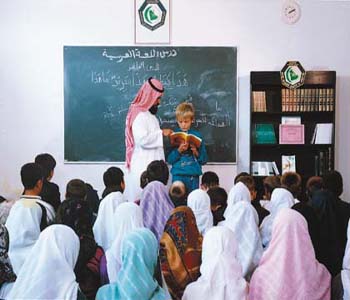The Arab world was facing great
amounts of social unrest during the anti-Western movements of the 1950s. These
opposition movements were mainly fueled by “anti-colonialism, nationalism, and
pan Arabism.” The movement for reform in Saudi Arabia was mainly caused by the
large gap between “the wealth and power of the ruling elite” and the poor, underprivileged
people of lower social classes. In Saudi Arabia, opposition groups are illegal,
but the social tensions amongst the people quickly led many to appear, the first
being the Front of National Reforms (FNR). The FNR’s ideals for Saudi Arabian
society included “an end to foreign and oil company domination, a constitution,
free press, elections, the right of assembly, abolition of slavery, and
improved education.”
 |
| Saudi Arabian Opposition Groups |
The
ideas of anti-colonialism, nationalism, and pan Arabism were specific to the
Arab countries, and drove people to ask for change. The ideals of
anti-colonialism were seen in the Baghdad Pact of 1955, which was an effort by
the United States to prevent the “domino theory”, which stated that once one
country falls to communism in Asia, the rest follow its path. The United States
had therefore decided to create an alliance with the Arab world. However, the
Baghdad Pact was a failure because “it was seen by Arab leaders as an attempt
by the West to continue its colonial domination over Muslim states”, and the
Arab world’s rejection of Western imperialism sparked new ideas for opposition
movements. The Baghdad Pact was also seen as a contradiction towards the ideas of
pan Arabism in the Middle East, the Baghdad Pact seen as an attack against the
promotion of Arab nationalism; which had been used as a tool to ward off
Western dominance and imperialism.
In
Saudi Arabia, the government was seen to be fighting off these opposition
movements and calls for reform by trying to promote the traditional values of
the nation and cut off the ideas of modernization from Saudi Arabian society. In
1954, King Saud had offered a 2,000 riyal prize to any citizen that could
memorize the Koran, a holy book that is an example of Saudi Arabian traditional
values. This reward was created as a response to the youth’s disregard towards
the studies of the Koran. The next year, any Saudi Arabian student who was
studying abroad was called back to Saudi Arabia, which is another example of
how the Saudi Arabian government fought against the Western ideas and teachings
to be implemented in their youth’s head.
 |
| The Flag of the Arab League symbolizes the ideologies of pan Arabism. |
The
population of Dhahran is made up of many “oppressed Shia”, a different believer
in Islam when compared to the Sunnis, “who made up the bulk of unskilled oil
workers, was a natural bleeding ground for reform groups and protest.” When
King Saud came to visit Dhahran in the year of 1956, he was resisted by groups
of people that were protesting for the closing of the air base located in
Dhahran and demanded for increased rights of the workers. Within a couple of
days, the King had banned the protests and strikers and had threatened the
resisters with three years in prison if they had violated his demands. The
names of the other protestors were provided by Aramco, and they were arrested
and beaten. Obviously, the citizens of Saudi Arabia were not granted the freedoms,
such as the freedom to protest/assemble, as those that are living in modernized
nations.
Again
in 1956, students in Najd had established Saudi Arabia’s “first student organization.”
The students had asked for the undoing of the League for the Propagation of Virtue
and Prevention of Vice and butted heads with the authorities. However, the government was not allowed to
punish their calls for reform because the state needed the students to manage
Saudi Arabia’s infrastructure.
Overall,
Saudi Arabia’s suppression of many people’s calls for reform may go against the
traditional and cultural values of the nation, and may cause the fall of the
monarchial regime and other components of the nation that could use updating. The
people’s cries for change and modernization can always help Saudi Arabia to succeed
as a more influential figure in the modern globe, that is, only if Saudi Arabia
is ready to listen.















.svg/250px-Saudi_Arabia_(orthographic_projection).svg.png)







